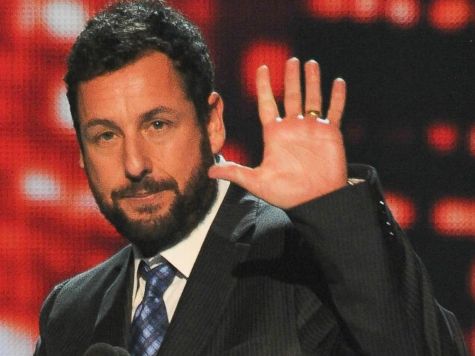Mere hours after buggy whip makers theatre owners here in America and around the globe collectively attempted to strangle the streaming/Imax deal between Netflix and The Weinstein Company in the crib, Netflix turned around and shoved its finger deep in the Hollywood system’s eye by signing Adam Sandler to a four picture deal.
This is big, big news for one very important reason: Adam Sandler is one of maybe five remaining movie stars left in the world. There’s Denzel Washington, Sandra Bullock, Will Ferrell, Seth Rogen, and Adam Sandler. That’s pretty much it. You don’t have to plop Sandler in a franchise and gamble on $200 in CGI to make a profit.
And now Netflix has Sandler (he will star in all four) for four movies. Four! American theatre owners just lost all the popcorn, soda, licorice whips, and nachos sold to millions upon millions of Sandler fans.
It would have been very easy for Netflix to go into the film business with no-name actors, or actors way past their prime, like a Steven Seagal. Grabbing an actual marquee name at a time when marquee names are rarer than government competence is a mammoth shot across the bow of the entire entertainment complex.
Tuesday I did some rudimentary (and simplistic-bordering-on-silly) math that looked at how Netflix can make a deal like this work. That math was based only on revenue from new Netflix subscribers attracted by a new title. The Sandler deal is different. This is a Netflix deal, not Netflix partnering with a Weinstein Company deal. This means that like a studio, Netflix can eventually move into and profit from whatever ancillary distribution areas it likes.
After streaming exclusively on Netflix, Netflix can do what the studios do: release the Sandler films on DVD and pay-per-view, sell the television rights worldwide, and even distribute the film theatrically worldwide.
On top of that, how much money will Netflix save that a studio couldn’t on advertising and print costs? The distribution and customer base is already built in. Obviously, the company will want to get the word out as a way to attract Sandler fans as subscribers, who are almost certain to look at a subscription as an amazing deal for the opportunity to see a new Sandler movie. You not only get to see a new Sandler movie for less than $10.00, you get access to a ton of programming for 30 days.
At the risk of getting sidetracked, this kind of deal is probably the future for films that are not big, event CGI tentpoles. With the era of the movie star coming to an end (no one in the above list of five is under 45), and the cost of production and advertising exploding by the day, the upside in taking comedies and dramas straight to home theaters is growing almost as quickly.
The boldness of Netflix continues to delight and astonish. Big business is every bit as corrupt and destructive as big government. Disruptors like this are gifts from the heavens.
Moreover, I love what this says about Netflix’s brand. Netflix earned its original production bones with shows like “House of Cards” and “Orange Is the New Black” — the kind of material that caters to The New York Times crowd. Sandler’s a populist talent. With the power and money Netflix currently holds, it’s good to know the company hasn’t had its head turned by America’s media elite. Netflix is still interested in catering to everyone.
And kudos to Sandler and his team for taking the leap.
John Nolte on Twitter @NolteNC

COMMENTS
Please let us know if you're having issues with commenting.